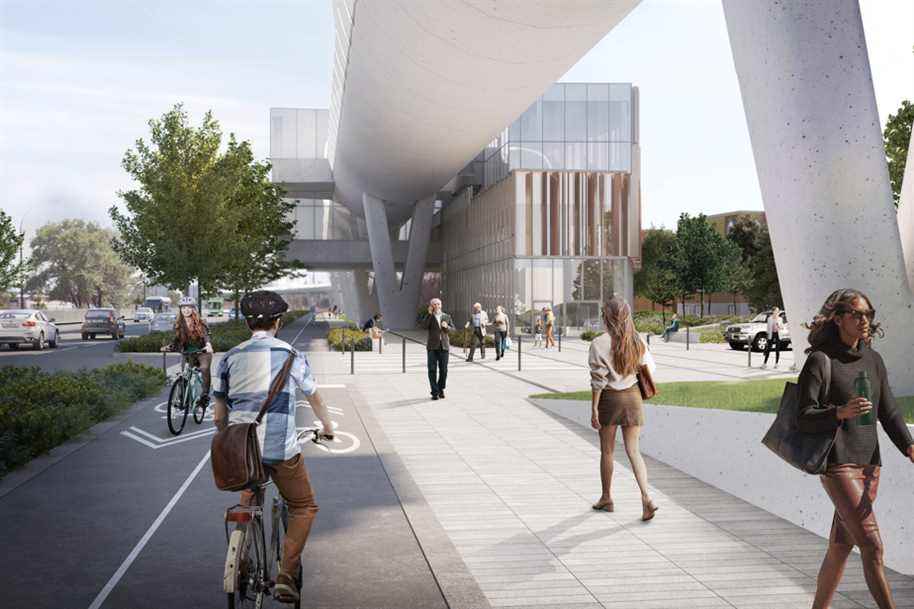Announced with enthusiasm in December 2020 by CDPQ Infra and the Legault government, the REM de l’Est quickly found itself embroiled in controversy. At the heart of the controversy: the erection of imposing concrete structures in the city center and in several other neighborhoods.
Posted at 6:00 a.m.
The Caisse subsidiary wanted to run its automated train through the middle of René-Lévesque Boulevard, starting at Place Ville Marie, then heading east, via Notre-Dame Street.

PHOTO PROVIDED BY CDPQ
CDPQ model of the Davidson station of the REM de l’Est
The proposal was considered so scandalous that the two architectural firms associated with the project resigned in February 2021. They refused to be associated with a permanent “ugliness” of the city center.
It must be said that the idea of erecting such a massive structure in the heart of the city goes against the trend of urban planning in recent decades. In Montreal, as in several other cities, the authorities have instead invested fortunes to demolish unsightly concrete structures.
The Pins interchange, at the foot of Mount Royal, and a portion of the Bonaventure Expressway, at the entrance to the city, have for example been flattened to make way for boulevards on a more human scale. The Ville-Marie highway, in a trench, was partly covered 20 years ago to reweave the urban fabric between Old Montreal and downtown. Ironically, it was the gleaming headquarters of the Caisse de depot that was cantilevered over this old concrete scar – a project that served as the spark plug for the redevelopment of the entire sector.
“Urban Divide”
Several experts – including those mandated by Quebec and CDPQ Infra to study the Eastern REM – feared an “urban divide” between the neighborhoods crossed by the train. Issues related to insecurity under the structure, noise and the protection of heritage sites have also been raised over the months.
Elsewhere in the world, several public transit projects have turned their backs on tall structures in central neighborhoods.
In Vancouver, for example, the authorities chose to pay more to bury a 5.7 km section of the SkyTrain rather than erect a concrete section deemed “hideous”, revealed an investigation by The Press.
In Paris, promoters of a metro expansion megaproject have also ruled out such structures for the same reason, deeming them part of a “1960s” vision.
The construction of a deep tunnel in the city center for the Eastern REM would have been technically “feasible”, according to two engineering studies commissioned by CDPQ Infra. However, the group considered that the financial risks associated with such a work were impossible to quantify and jeopardized the profitability of the project.
Governance issues
The Caisse subsidiary made several changes to the Eastern REM along the way in hopes of making it more palatable. The group notably suggested digging a station and a short 500-meter tunnel downtown, moving a problematic section to Sherbrooke Street East and proposing a more elegant architecture than that of the first phase of the REM – with concrete paler and more discreet catenaries.

PHOTO HUGO-SÉBASTIEN AUBERT, LA PRESSE ARCHIVES
Raised structure of the REM under construction in the West Island, last September
These changes were not enough to allay fears. The issue of governance has also become increasingly thorny in recent months, as the City of Montreal demanded to have a say in the development of the project, which would have required investments of more than $1 billion from Montreal taxpayers. .
The committee of experts set up to study the project was officially dissolved on Monday afternoon, learned The Press. Two of its members gave us their mixed impressions of the turn of events.
Christian Yaccarini, CEO of the Angus Development Corporation, says he is happy that Quebec and Montreal “save the project”, but regrets the disappearance of the direct link with the city center in the future version. He hopes that the option of an underground connection to the business district will be studied in the coming months.
Christian Savard, founder and president of the Vivre en ville organization, would also have liked a tunnel link to the city center. “There, we find ourselves with a project that raises a lot of questions. »

